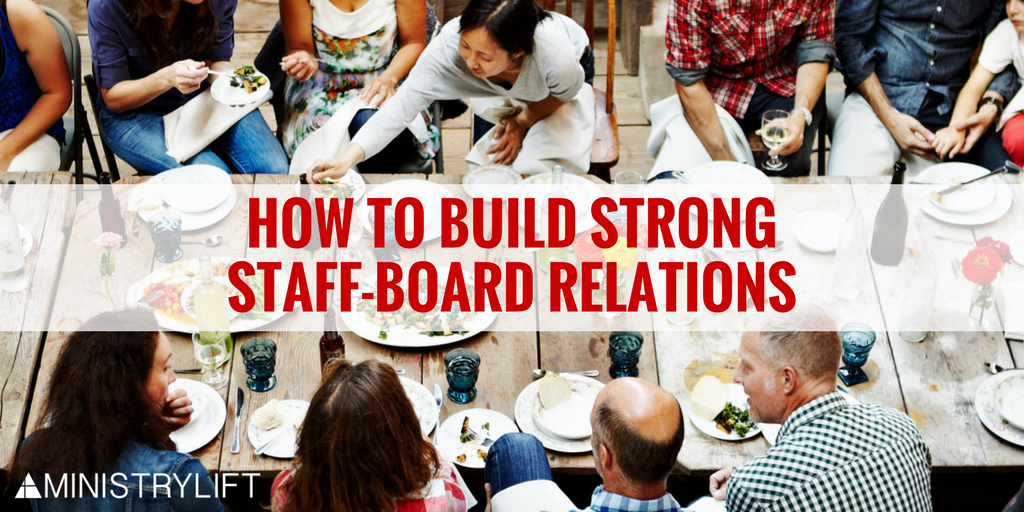How to Build Strong Staff-Board Relations
 The growth of an organization often depends on the strength of the working relationship between its board and staff. Stephen M.R. Covey writes:
The growth of an organization often depends on the strength of the working relationship between its board and staff. Stephen M.R. Covey writes:
There is one thing that is common to every individual, relationship, team, family, organization, nation, economy, and civilization throughout the world—one thing which, if removed, will destroy the most powerful government, the most successful business, the most thriving economy, the most influential leadership, the greatest friendship, the strongest character, the deepest love. On the other hand, if developed and leveraged, that one thing has the potential to create unparalleled success and prosperity in every dimension of life. Yet, it is the least understood, most neglected, and most underestimated possibility of our time. That one thing is trust. {1}
Trust is the foundational element for building a strong board-staff team. Yet, how do we build trust in this strategic relationship? Here are some ideas to consider:
1. Spend time together
There is no substitute for just hanging out together in a relaxed, fun environment. For example, in the churches where I have served, we have done board-staff meals and retreats. When I was starting out in pastoral ministry, my lead pastor would remind the staff team to make the most of our overnight leadership retreats by spending time with non-staff leaders. It was prime time to build relationships.
The primary relationship in the board-staff team is between the lead pastor and the chair/moderator. If you are one of those people, make sure that you meet with your counterpart once or twice a month (preferably for a relaxed discussion over coffee or a meal). Build a strong relationship even as you discuss church matters.
It’s also important to encourage or even structure regular interactions between individual board members and staff.
Relationships provide the context in which trust can flourish.
2. Over-communicate
Distrust can sometimes build because of a lack of information or misinformation. Employ mechanisms so that board members know what staff are doing and the challenges they face. Staff also need to hear about board discussions and the heart behind them (this is a key responsibility of the lead or executive pastor if not all of the staff are on the board). Seeing and knowing about the actions of others can often help build credibility when those actions are perceived as honorable and supportive of the organizational mission. This knowledge also provides a context for understanding subsequent board and staff actions and even reactions from others in the church.
3. Focus on mission together
Board members and staff will have a stronger working relationship when they rally together around a shared mission.
4. Avoid triangulation
People in the church will sometimes take a ministry concern to a board member instead of going directly to the staff person who oversees that ministry. This kind of triangulation is highly dysfunctional and breeds distrust. On one board I served, we actually had to add “avoiding triangulation” to our board code of conduct because it was such a problem.
5. Avoid micromanagement
Board members often wear multiple hats. For example, it’s natural for a board member who also serves as a small group leader to want to speak into the running of the small group ministry. Yet, it’s important that board members take a higher view of church matters, especially as a church grows in size (more on this with #9 – Adjust Your Governance Model as Your Church Grows).
6. Deal with points of tension
The best time to deal with conflict is when it first starts. As interpersonal and philosophical tensions emerge between board and staff, it’s important to name and discuss them. Conflict can actually help strengthen board-staff relations when dealt with in an open and loving way.
7. Remember that individual board members are not the board
Sometimes, well-intentioned board members will approach staff members about a concern they have about them or their ministry. It’s imperative that board members, including the chair, make it clear that they speak for themselves unless the board has authorized them to speak on behalf of the board. It’s easy for a staff person to get the impression that any board member speaks for the entire board.
8. Conduct regular, strengths-based staff evaluations
In the blog, Five Tips for Effective Staff Evaluations, I try to make a case for focusing on strengths when doing staff evaluations. Obviously, staff members may need to shore up weaker areas or recruit others to help in those areas. However, when people focus on using and developing their strengths, they tend to be much more effective and fulfilled. This is good for the staff member and the organization.
9. Adjust your governance model as your church grows
As a church grows in size, it is necessary to move beyond a management board to more of a strategic leadership board (if you don’t, the church will likely stall in its growth). By the time a church hires a second pastor (if not sooner), it is important that board members start relinquishing ministry management to staff members. The board can then focus even more on providing visionary leadership, spiritual care and developing policies that provide useful parameters for staff as they develop their ministries.
Edward Marshall has said, “Speed happens when people…truly trust each other.” My hope is that the ideas I’ve shared in this article will help to build trust on staff-board teams, so that they can increase their speed in accomplishing God’s mission for them.
Note: You can access more resources on how to build healthy governance boards on MinistryLift’s Healthy Boards page.
Randy Wollf is Director of MinistryLift and Associate Professor of Practical Theology and Leadership Studies at MB Seminary.
{1} Stephen M.R. Covey, The Speed of Trust: The One Thing that Changes Everything (Free Press, 2008).
